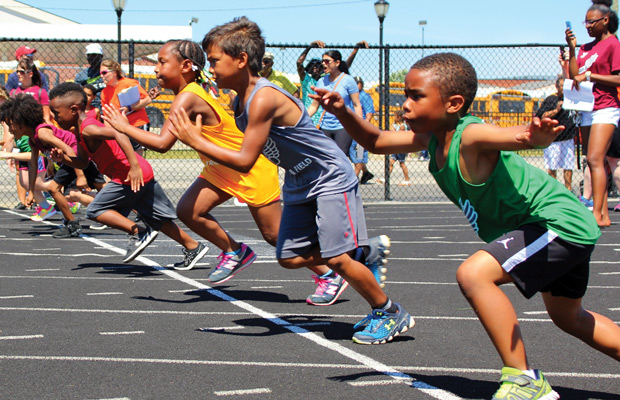In the field of community recreation, children are offered a multitude of sports. To encourage youth participation, it’s important to offer the most popular programs and make them stand out.
One of the first steps is to have great coaches. According to Amber Miller, the associate program director of sports and teens at the Benjamin Harrison YMCA of Greater Indianapolis, having amazing volunteer track coaches has helped increase participation. “I happen to be blessed with a husband and wife duo who love track, love to help kids, and teach them to work hard, have fun and do their best,” she said.
Although track still isn’t as popular as basketball in Indianapolis, Miller has enjoyed seeing the program grow. “It’s becoming something parents are getting more and more interested in,” she noted. “When the program first started, we had about 20 kids. Since I’ve been here, we’re up to around 80 to 90.”

Melvin Reid, the youth sports director at the Silver Spring YMCA of Metropolitan Washington, believes coaching makes a difference. “Whoever you teach in sports or class, you’re using teaching skills, but we also teach kids as people,” he said. “We try to be an example in the way we carry ourselves with our core values — respect, honesty and responsibility.”
To maximize the reach of youth sports, it’s important to have multiple branches coordinate their programs when applicable. Once a month, the Indianapolis Y brings together all 12 of its sports directors to ensure they’re being consistent. “We make sure we’re all on the same page and offering the same thing around the same time — we just tweak it a little, based on the community and what its needs are,” explained Miller.
From these meetings, they developed a technique they collectively use, called “All-City Events.” At these events, teams from each of the branches compete against one another in the most popular programs.
According to Miller, the All-City Events have increased participation in the track and cross-country programs. “Being able to say we are five-time defending champs helps us draw in our kids and get others interested in the sport,” she said.
Additionally, the basketball program has a similar competitive edge. By offering travel basketball, participants get to visit other Ys in their association and compete in a large tournament. “We get a lot of newbies — kids who have never played the sport, but want to learn how to play it,” said Miller. “But I also have my returning kids who want to go to that next level.”
Miller said this is why they introduced travel basketball into their program — to accommodate the more experienced youth. “It’s like March Madness,” she said. “You’re one and done, so you have to fight to get to the championship.”
At the Silver Spring Y, youth are mostly interested in basketball and eager to participate. “Most of our kids play basketball here, then they go on to play in high school or junior high,” said Reid. “So there’s a pretty big turnover — not because of us, but because they learned the right way.”
Reid also emphasized their youth programs are not necessarily focused on being competitive. “There’s focus on everyone getting a chance to succeed — everyone wins each day,” he said. “We feel if a kid has a good day in camp or a good day in a sports program, it helps them as a child or within their family.”
In addition to teaching, Reid has found summer camps are the biggest market for attracting youth participants. One feature at the Silver Spring Y is the sports festival they host during summer camp, which starts in the morning and runs on a schedule throughout the day, allowing participants to learn and play a variety of sports.
The benefit of hosting a sports festival is introducing a fair playing model. “Some kids may come to camp for social reasons or athletic reasons, and some may come for self-esteem or personal reasons,” said Reid. “Everyone should get a chance, and everyone should have proper instruction.”
This is not to say there is no room for competition in youth sports. “During the winter, we have a basketball league,” said Reid. “It’s semi-competitive and that’s when they compete.”
Whether youth in your community have a competitive drive or not, the best marketing technique for programs tends to be word of mouth. “We advertise through paper flyers, previous members, signage, and summer camps, but predominately 70 to 75 percent of it is word of mouth,” said Reid.
Miller echoed Reid’s sentiment. “Luckily, a lot of my kids I get by word of mouth – a parent hears about it through a friend and decides to get their kid signed up,” she said.
More than just providing entertainment and physical activity, it’s important to note several other benefits youth sports provide. Gilbert Duran, the youth sports director at Yakima Family YMCA, feels developing social and motor skills are the most beneficial aspects of youth sports.
“Youth sports is a learning curve where kids can develop and be introduced to team sports,” said Duran. “It also helps relationship-building within the community.”
No matter what marketing technique or unique event you use to make youth sports stand out, the main focus comes down to the participants and community. Miller has found connections with the youth, parents and volunteers have been very beneficial. “Each team becomes its own small community and gives a chance for kids and parents to make new friends,” she said.
Reid attributes the Y’s values to running a successful and beneficial youth sports program. “Within our programs at the Y, we have a terminology: we live it, we do it and we watch it,” he said. “We try to build strong kids, which leads to strong families, which we believe, leads to a strong community.”










